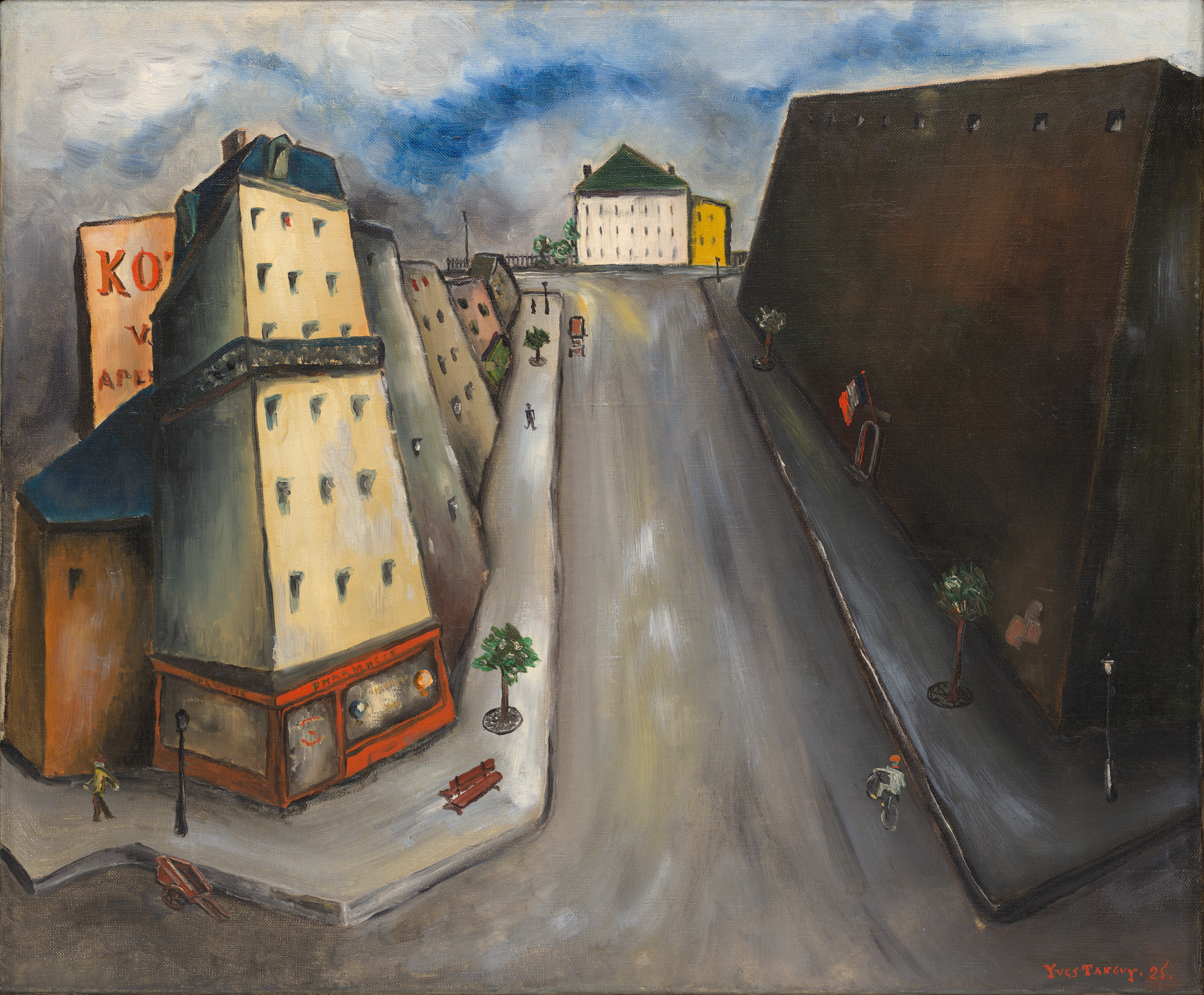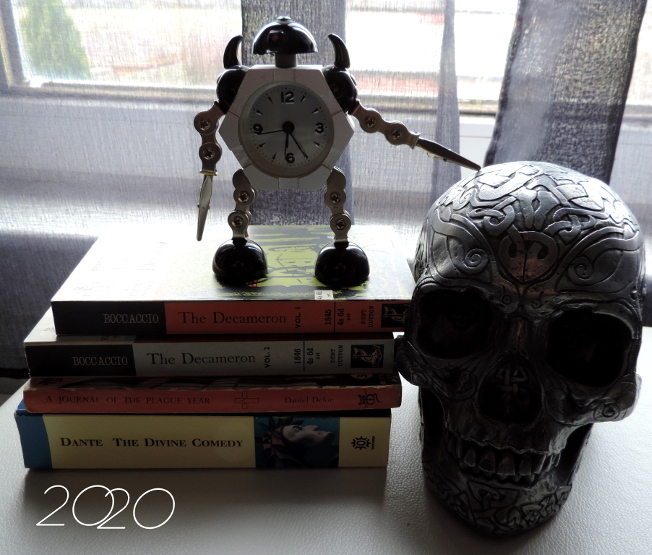Prelude: Getting older while time stands still
Apparently today, when I’m writing this, is five years to the day since the first (and even then, belated) UK lockdown of the Covid-19 pandemic. A strange thing to have experienced then, it almost feels like a dream now. There was much discussion, online and on TV during that unusually warm and pleasant spring and summer, about how life and the world would be changed by it. Some of that discussion was oddly hopeful, even among the shocking daily mortality figures and news reports about medical facilities in the UK running out of bodybags. I remember those reports about the canals of Venice having fish in them for the first time in decades; I remember the wildlife around here (being in a quiet rural area meant that a daily walk was permitted without being aggressively policed) becoming unusually bold and visible. And though of course business was suffering and various goods becoming ridiculously expensive or hard to find, the world didn’t come to an end.
The thinking was that, since we had proved that the roads needn’t always be choked with cars or the skies busy with air traffic, and that nature bounced back far more quickly than could have been expected, perhaps the key to ecological recovery was within our grasp. But that’s not how things worked out; the second that it was possible to do so, the roads filled up, the airports were busy again and yet somehow it worked out so that all the negativity associated with capitalism went back to normal but prices didn’t.
And now I think everyone who lived through that time is discovering why we grow up learning plenty about the First World War but not about the Flu pandemic that killed more people in its aftermath. Not I think because it was too horrible to talk about or too difficult to put into words, but because when it’s done you just get on with other stuff and before you know it those events have an undramatic sense of unreality hanging over them; too tedious to talk about. I had the feeling during that time that the only way it would have been taken genuinely seriously (lockdown was serious, but people mostly whined about it rather than cowering in their homes) would be if it had been a disease as dramatic and visible and fast-moving as the Black Death. Maybe if people were rotting before our eyes, the dead lying in the streets, there wouldn’t have been all the debate and denial and conspiracy theories; I’m glad we didn’t find out.
Oh well; the pandemic was an experience and, aside from the death and horror, I have to admit I quite enjoyed the strangeness, the empty streets, the quietness, the masks. Not so much queueing outside of shops in single file with 6-foot gaps. But anyway; this was written during that first (by the sound of it, quite relaxed) lockdown, five years ago but feels like it could have been twenty….
“Ane doolie sessoun” covid-19 and the art of isolation
At some point in the late fifteenth century, the poet Robert Henryson (who lived in Dunfermline, not too far from where I’m writing this now), began his Testament of Cresseid with one of my favourite openings of any poem:
Ane doolie sessoun to ane cairfull dyte
Suld correspond and be equivalent.Robert Henryson – The Testament of Cresseid and Other Poems, my edition Penguin Books, 1988, p. 19

I don’t think I knew, word for word, what Henryson was saying when I first read those lines, but I did get the meaning: essentially that miserable/sad/grim times call for miserable/sad/grim poetry. I guess ‘doolie’ would be ‘doleful’ or ‘dolorous’ a few hundred years later; not sure what it would be now. ‘Cairfull’ sounds far more familiar, but in this case means literally ‘full-of-care’ as in the more woeful sense of caring about things than the casual one we would usually use. The words, with their mixture of strangeness and familiarity (people in Scotland have not talked like that for many centuries, but I think that being attuned to the accents and patterns of speech here probably still makes it easier to understand), stayed with me.
The poet goes on to talk about the weather; apparently it was an unseasonable Lent in Fife that year, when “schouris of hail can fra the north discend/that scantlie fra the cauld I micht defend.” Despite impending climate disaster, Fife weather hasn’t changed beyond all recognition it seems; It was only two weeks ago – though it seems far longer now – that I was caught in a hailstorm myself.
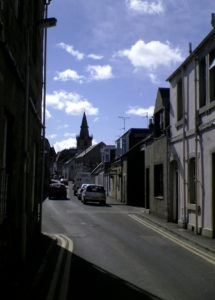
The season is still doolie however; not because of the weather, but because of the pandemic sweeping the world, one unlike any that Henryson would have known, but which probably wouldn’t have surprised him too much. One of the key elements he brought to his version of the Troilus and Cressida story in The Testament of Cresseid is its heroine being struck down by leprosy and joining a leper colony. The cover of my copy of his poems (above somewhere) has a drawing from a medieval manuscript, of a figure which would have been familiar to most readers at the time; a leper with a bell begging for alms.
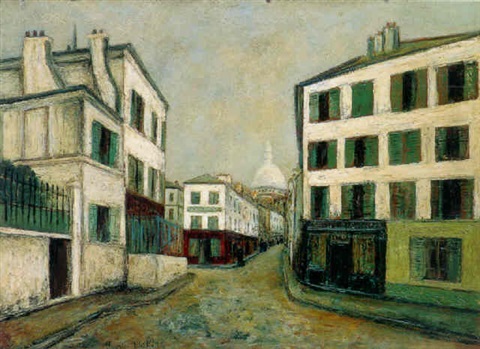
In fact, with dependable cosmic irony (or if you are less fatalistic, normal seasonal progress), the weather, since #stayhome has been trending online and quarantine officially recommended, has been beautiful here. The streets are fairly, but not yet eerily, quiet. So this particular dyte (the old word that Henryson used referred to his poem, but I think stems ultimately from the Latin dictum that can apply to any piece of writing) may not seem especially gloomy (and may in fact be quite sloppy), but it is certainly careful in the sense that Henryson intended. It’s quite easy – and I think reasonable – to be optimistic about the state of the world in April 2020, but not I hope possible for anybody with any sense of empathy to not be concerned about it.
There are some silver linings to the current situation (major caveat: so far). As well as – inevitably – bringing out the worst in some people, a crisis also brings out the best in many more. And a whole range of major and minor plus points, from a measure of environmental recovery to time to catch up with reading, have emerged. For me, one of the nicest things to come out of the crisis so far is – thanks to social media – the way that arts institutions, while physically almost empty, have begun to engage online with a wider range of people than those who are likely to, or physically able to visit the galleries themselves.
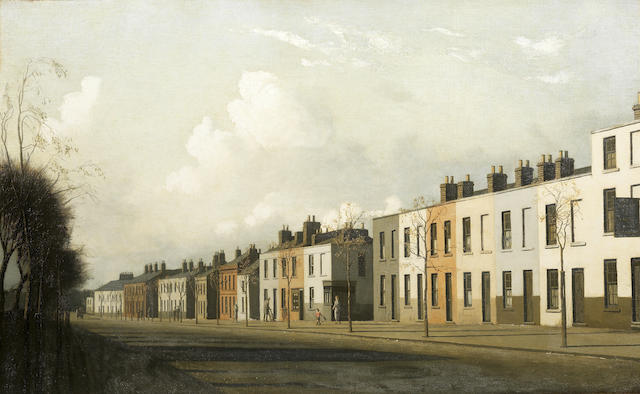
It has been said that Edward Hopper is the artist who has captured this particular moment best, and it’s true that his vision of loneliness in the metropolis particularly mirrors our own age of social media and reality TV, in that it is voyeuristic (not a criticism, visual art is by definition voyeuristic). Online, we are not looking at ourselves, or at an absence of people, we are looking at other people whose isolation mirrors our own. If there’s something about this particular pandemic that sets it apart from the Spanish flu of 1918-19 or the great plague of 1665 or the Black Death of 1348-9, or any of the devastating outbreaks of disease that sweep the earth from time to time, it’s that online we are (a ridiculous generalisation perhaps, but if you’re reading this chances are you have internet access at least) sharing the experience of isolation; surely in itself a relatively new phenomenon, at least on this kind of a scale. When Daniel Defoe wrote in his fictional memoir of the 1665 plague (and it’s worth remembering that, although he was only five when the plague swept London, he would have had the testimony of many who had survived as adults as well as whatever shadowy memories he himself had of the period) –
Passing through a Token-house Yard, in Lothbury, of a sudden a casement violently opened just over my head, and a woman gave three violent screeches, and then cried “Oh! Death, Death, Death!“in a most inimitable tone, and which struck me with horror and a chilness in my very blood. There was nobody to be seen in the whole street, neither did any other window open; for people had no curiosity now in any case; nor could any body help one another
Daniel Defoe, A Journal of the Plague Year, 1722, my copy published by Paul Elek Ltd, 1958, p. 79-80
– he was depicting a situation which many people could no doubt relate to; when they read it, long after the fact. What we have now is a sense of shared helplessness in real time; this has never existed, quite in this way before. Assuming some kind of return to normality, we (not entirely sure who I mean exactly by ‘we’) will know each other better than we ever have; which is something to have mixed feelings about no doubt.
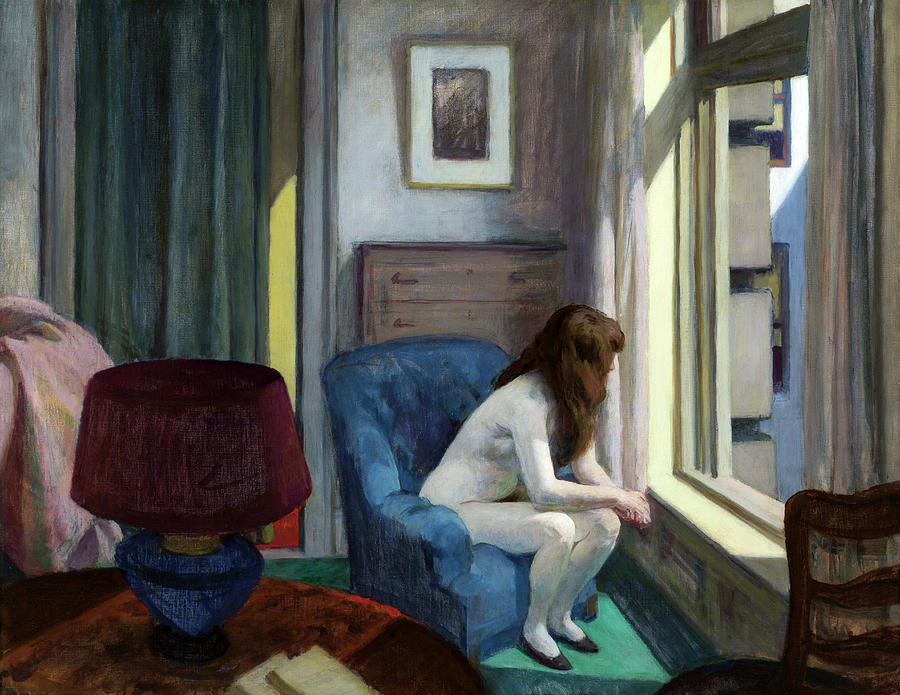
The current appeal of Edward Hopper’s paintings of lonely figures is humanistic and easy to explain. His art, with its depiction of strangers quietly sitting in anonymous places, people who paradoxically we can never know and never know much about, but who we can easily relate to, is profoundly empathetic. It belongs to a long tradition of quiet loneliness or at least alone-ness that stretches back, in Western, art to the seventeenth century and the art of Vermeer (it’s easy to forget, as the children of it, but the idea of art reflecting the individual for reasons other than wealth and status is an essentially Protestant one*) through artists like Arthur Devis (though I’m not sure he intended the quiet melancholy of his paintings though) and Vilhelm Hammershoi (he did). In fact, Hammershoi’s beautiful turn-of-the (19th-to-20th)-century paintings are if anything even more relevant to stay-at-home culture than Hopper’s diner, bar and hotel-dwelling urbanites. With Hopper, we are often watching – spying on – his characters from the outside, as if through a pair of binoculars, with Hammershoi we are shut in with them, like ghosts haunting their silent rooms.
Really, the only ‘lonely’ figures in pre-Protestant European art are Christ himself (think of the utter solitary misery of the crucified Jesus in Grunewald’s Isenheim altarpiece) and of course Judas, or those who that, like him have separated themselves from Christianity. There is a terrifying solitary quality in some depictions of saints during martyrdom, but for their contemporary audience it was essential to bear in mind that they were not spiritually alone (note: this may be a completely false assertion)
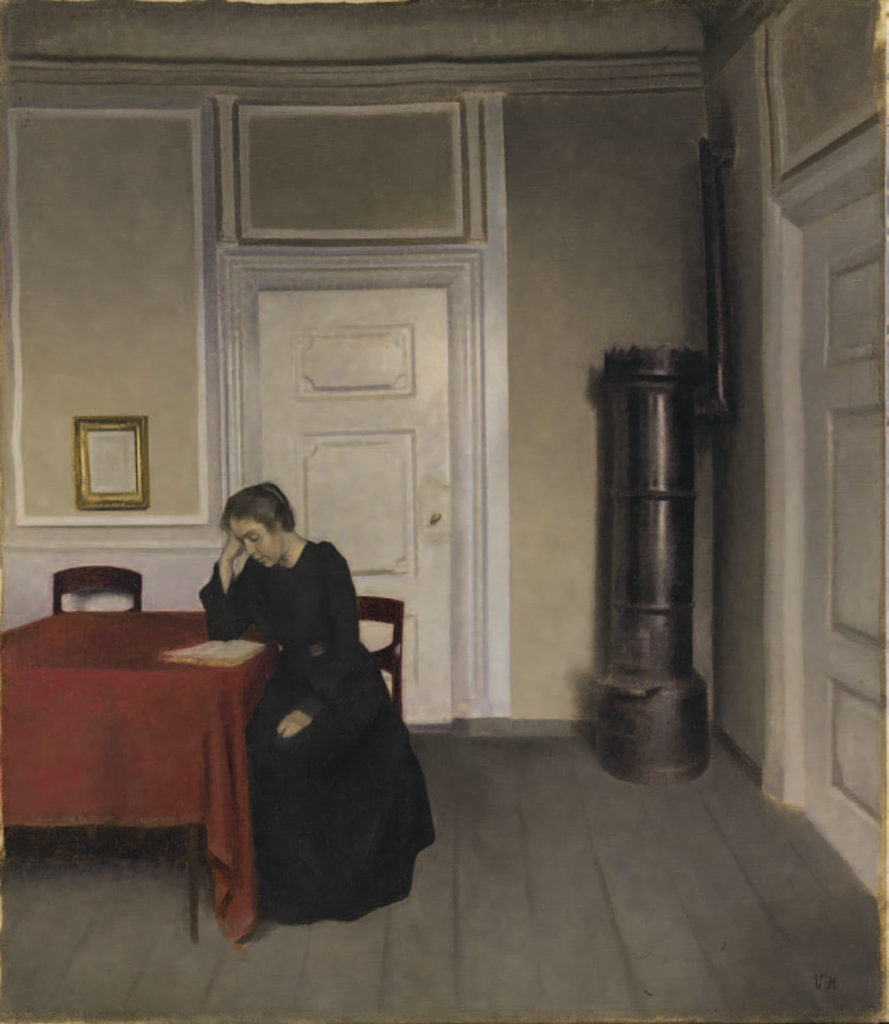
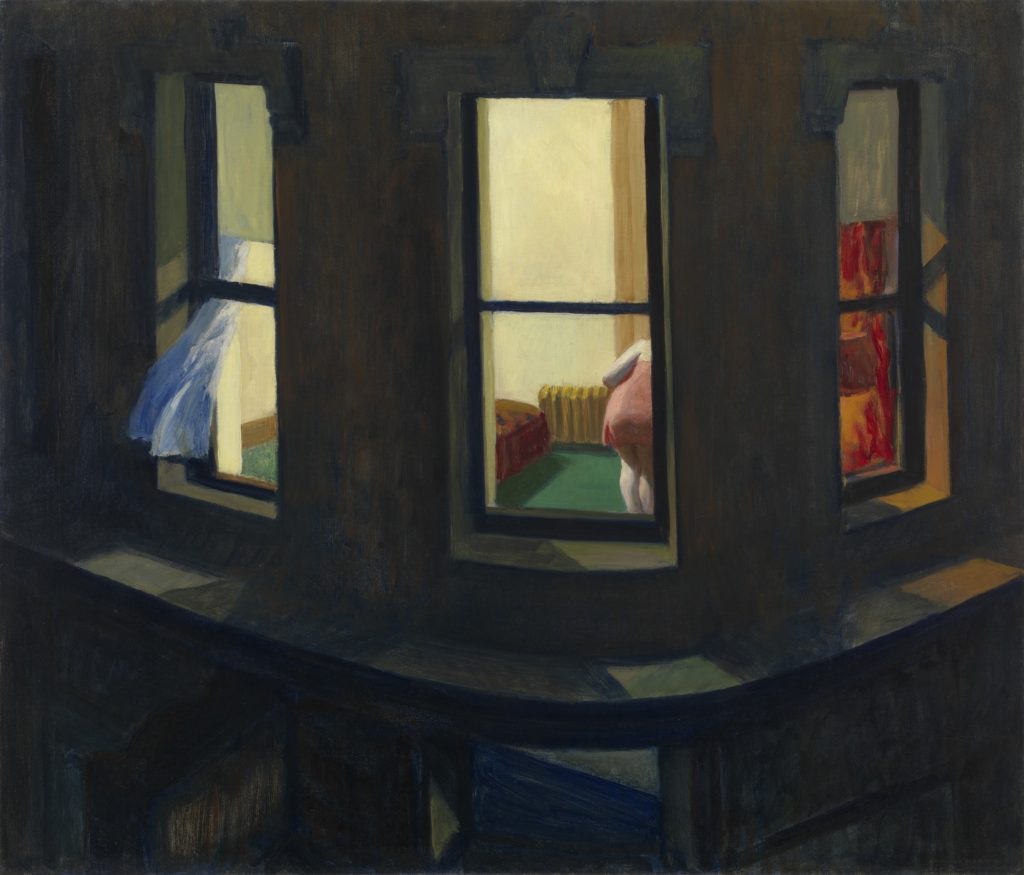
Hopper’s most discussed and shared works now are those where we seem to catch, as we do from a train window, a momentary glimpse of a life that is utterly separate from our own. It’s a feeling I strongly associate with childhood and (very) specifically, with travelling through Edinburgh in the winter and seeing glimpses of people at windows and the high ceilings in the big Georgian townhouses in the New Town when their Christmas decorations were up. Who were all these people? What were their lives like? Why was this such a melancholy experience? Who knows.
But there are other kinds of Edward Hopper paintings too – including some of my favourites, like Early Sunday Morning (see below) – where the only human presence is the artist, or the viewer, where Hopper could claim (though I have no idea if he would have) like Christopher Isherwood, I am a camera with its shutter open, quite passive, recording not thinking.* But recording, for a human being, is thinking. And the picture of a place-without-people is rarely as simple as it seems; even in the case of an actual photograph. Someone had to be there to photograph it, and had their human reasons for doing so. The tradition of landscape painting exemplifies this; landscapes may be mythical, romantic, epic, realistic, but they have been recorded or edited or invented for a variety of complex human reasons. The landscape painting of earlier eras was often self-consciously beautiful, or psychologically charged (Caspar David Friedrich is the classic example; landscape as a personal, spiritual vision; in some ways his work, with its isolated or dwarfed human figures, is kind of like a romantic-era Hopper), but the fact that the urban landscape is itself an artificial, human-constructed environment gives it a different, poignant (if you are me) dimension.
*Christopher Isherwood, Goodbye To Berlin, in The Berlin Novels, Minerva 1992, p. 243.
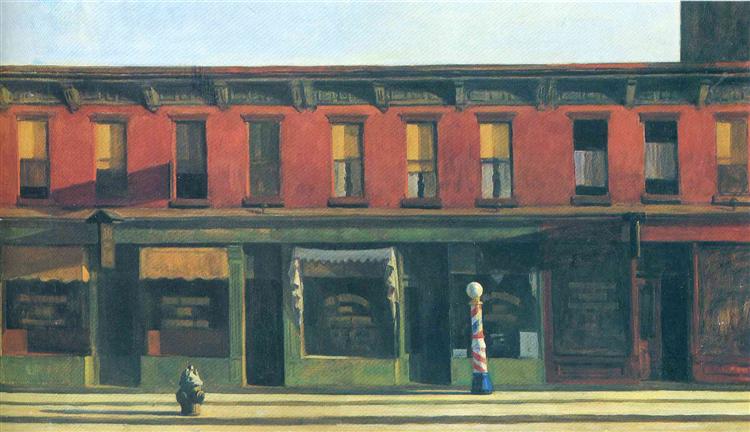
The appeal of the empty urban landscape in art is perhaps hard to explain to those who don’t see it, but I think it’s worth examining. There is a utopian tradition beginning with (or at least exemplified by) the ‘ideal cities’ produced in Italy in the late 15th century that is in a strange way misanthropic (or at least anthro-indifferent) in that the tranquil geometric perfection of the imaginary cities can only be made less harmonious by the introduction of human figures. But it’s also important to note that these cityscapes actually pre-date landscape painting for its own sake in western art by a few centuries. I don’t think it’s much of an exaggeration to say that in the medieval and renaissance period, the urban landscape had a far greater claim to represent paradise than the natural one. The garden of Eden was a garden after all, not a wilderness, and even the word paradise denotes a walled enclosure in its original Persian meaning. We might think now of paradise existing beyond the realms of human habitation, but in ages where the landscape was mainly something perilous to be passed through as quickly as possible on your way to safety, the controlled human landscape had a lot to be said for it.

Like the Renaissance ‘ideal city’, the beautiful post-cubist-realist paintings of Charles Demuth have a sense of perfection, where the severe but harmonious geometry of his industrial buildings seems to preclude more organic shapes altogether.
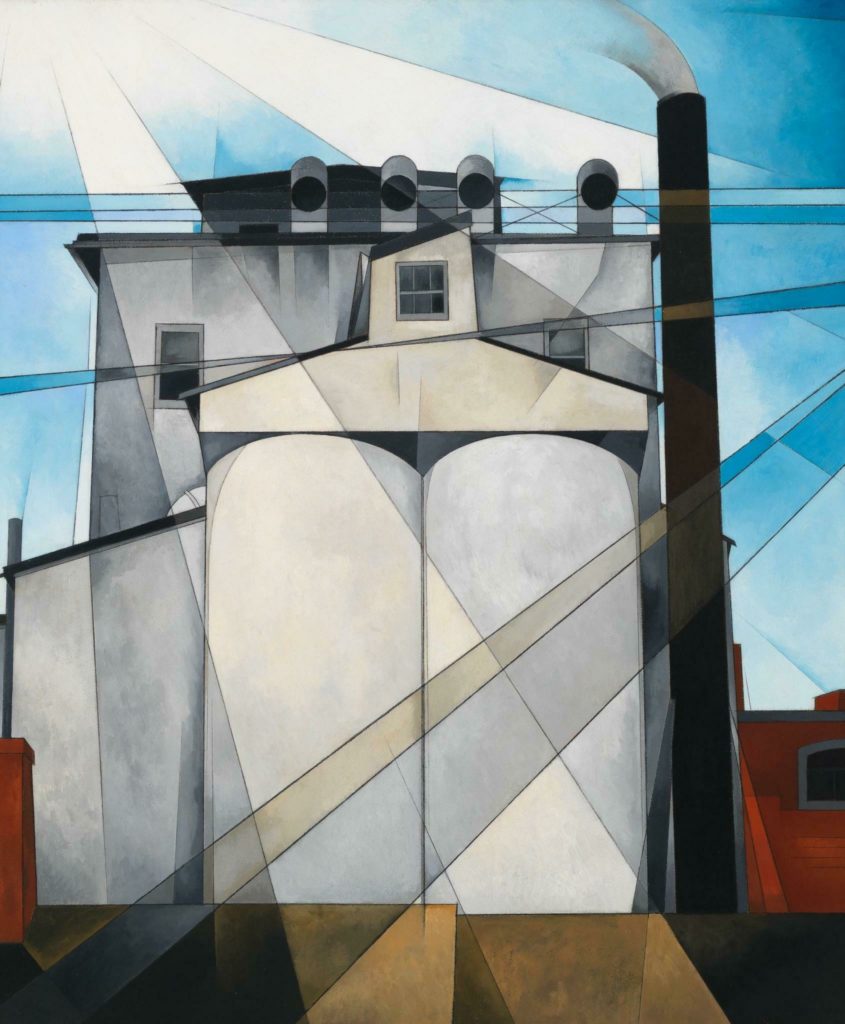
But if Demuth shows an ideal world where human beings seem to have designed themselves out of their own environment, the ideal cities of the Renaissance, with their impossibly perfect perspectives are something more primal and dreamlike; prototypes in fact for the examinations of the inner landscape of the subconscious as practised by proto-surrealist Giorgio de Chirico and his actual-surrealist successors.
De Chirico’s eerie ‘metaphysical’ cityscapes are essentially those ideal Renaissance cities by twilight, and artists like Paul Delvaux used the extreme, telescoped perspectives of the early Renaissance to create their own prescient sense of urban displacement. Why the kind of linear perspective that sucks the eye into the distance should so often be, or feel like, the geometry of dreams is mysterious – one plausible possibility is that it’s the point of view that first forms our perception of the world, the low child’s eye view that renders distances longer and verticals taller; we may be the hero (or at least main protagonist) in our dreams, but that definitely doesn’t mean we dominate them.
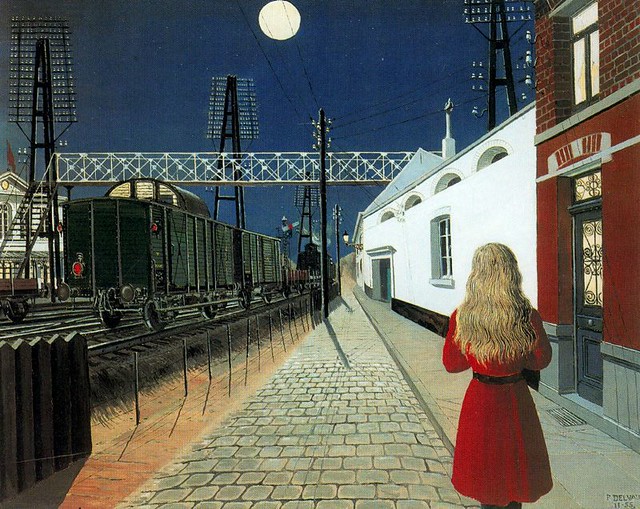
The use of isolated human figures, as in Delvaux and Hopper’s work, gives us a ‘way in’ to a picture, something human to either to relate or respond to (although Delvaux – like Magritte in Not To Be Reproduced (1937) – emphasises the loneliness and again the ultimate unknowable nature of human beings in Isolation by showing the figure only from behind), but the cityscape that is devoid of life, or which reduces the figures to ciphers, has a very different appeal.
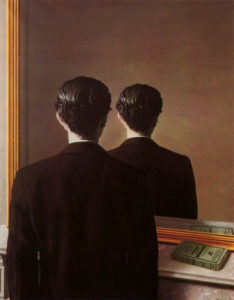
Whereas the unpopulated landscape may suggest a prelapsarian, primordial or mythical past, or an entirely alien realm altogether, empty streets are just that; empty. These are utilitarian environments designed specifically for human beings and their patterns reflect our needs. A meadow or hillside or mountain with no visible sign of human life may be ‘unspoiled’; towns and cities, by this definition, come ‘pre-spoiled’, and the absence of people raises questions that a natural landscape usually doesn’t; Where are the people? What has happened?
That said, nothing about Hopper’s Early Sunday Morning, Algernon Newton’s paintings of Kensington (or Takanori Oguiss’s Paris, or indeed the beautiful photographs of the city in Masataka Nakano’s Tokyo Nobody (2000)) really suggests anything ominous or post-apocalyptic – but even so, the absence of life is the most noticeable thing about them. Whether intended or not, this gives a picture a psychological depth beyond that of a simple topographical study. In still life paintings from the Renaissance onwards, the use of objects with a purpose, for example musical instruments, was always more than just something pretty to paint. Whether the instrument in question was there to express the fleetingness of time (music fades away quickly), discord (a lute with a broken string etc) it was never just an object. And so in the urban landscape, objects with a specific purpose (roads, paths, buildings) apparently not fulfilling that purpose, creates a response as complex as – though very different from – the feeling of looking at those lonely figures in Hopper and Hammershoi’s paintings. Not so different in fact, from the feeling of leaving your home in the spring of 2020 and walking down the deserted street outside.
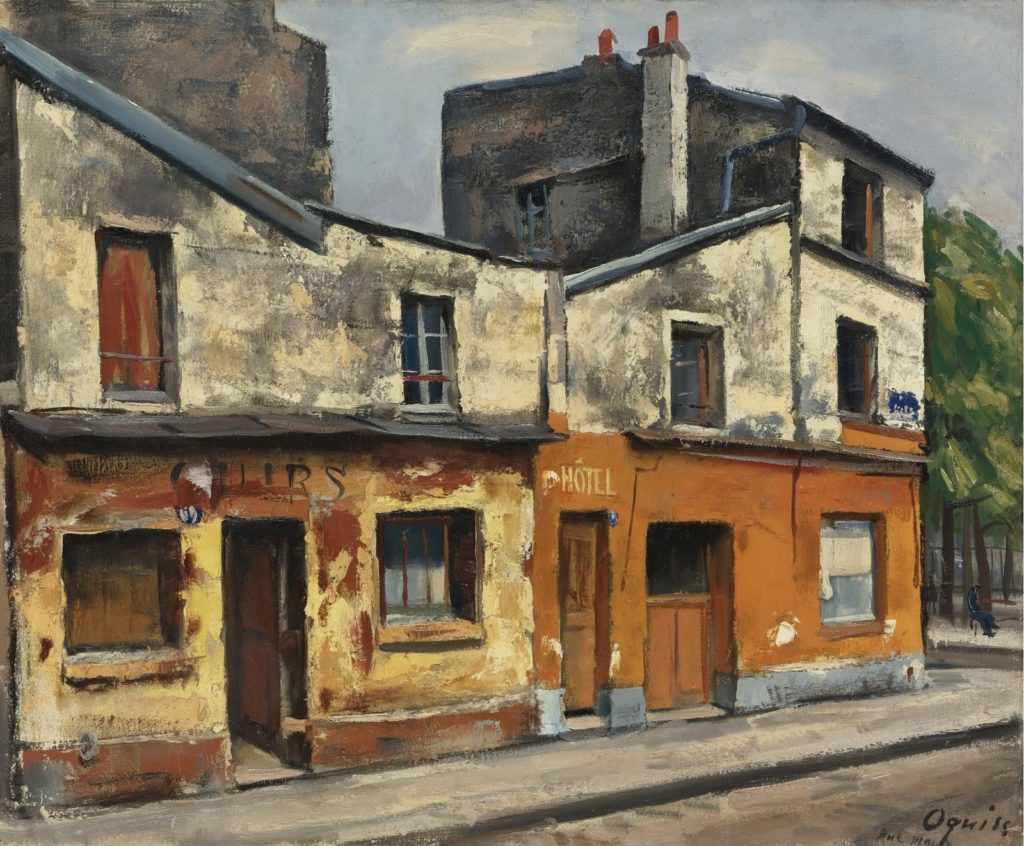
These paintings can have a slightly uncanny quality reminiscent of the eerie opening scenes (the best parts) of movies like The Omega Man (1971) and 28 Days Later (2002) or John Carpenter’s classic Escape From New York (1981) where, emptied of people, any sign of life in a city becomes, not a sign of hope, but threatening and full of sinister power. Things will hopefully never reach that point in the current crisis, but as it is, avoiding people in the street is for now the new norm; for the first time I can remember, my natural reserve feels like a plus.
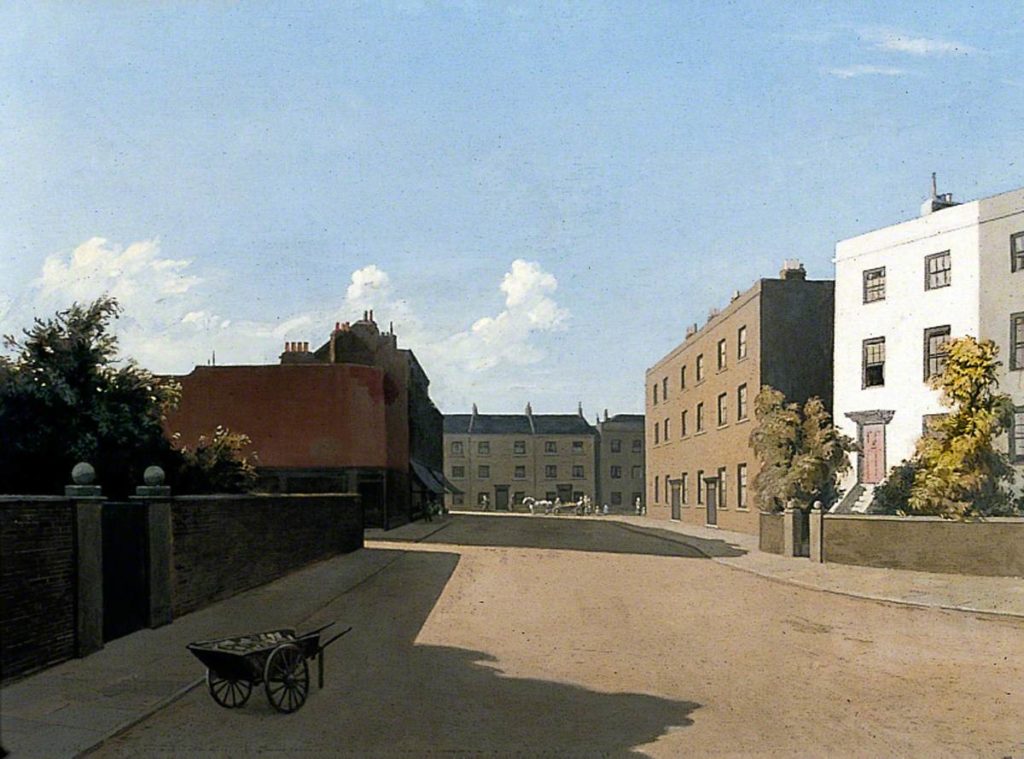
Those 15th century ‘ideal cities’ were part of the flowering of the Renaissance, and, as with every other aspect of it, they were the product of people looking backwards as much as forwards. The actual, non-ideal cities that were lived in by the artists who painted those pictures were largely organic, messy, medieval conglomerations, regularly visited by outbreaks of disease. The ideal city’s emptiness is not only harmonious and logical, it’s clean. And like the classical sculptures, bleached white by time and weather which were to prove so influential on that generation of artists, the aspiration is towards a kind of sterile perfection which never really existed until long after the culture that created the buildings and the art, had disappeared to leave just a ghostly husk of its former self.
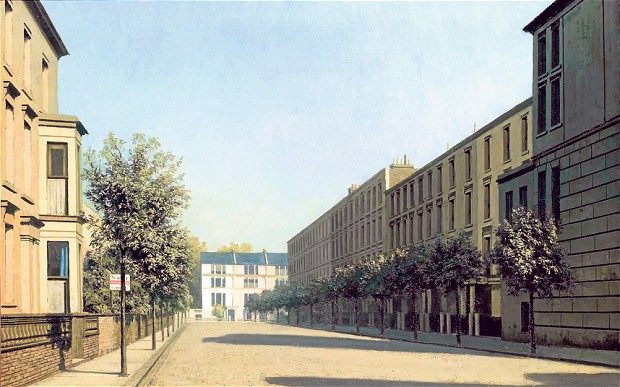
The deserted city or townscape more or less disappears from art from the 15th century until the later years of the industrial revolution, when urban life itself became the subject for modern art. And it makes sense; the reversal in European culture which saw city life become perilous and the countryside as a means of escape was a slow one, and the solution (never more than a partial one) was in building programmes, urban renewal and harmonious town planning; Empire building and colonial expansion fuelled the growth of urbanisation and were fuelled by it; to imagine an empty city at the height of Empire was to imagine extinction. If there was any remaining collective memory of empty streets in the late 19th century, it was probably an echo of the kind of scenario that Defoe had written about*; less graced by the muses of harmony than haunted by the dead.
*or of natural disasters like drowned villages, or man made catastrophes like the Highland Clearances.
But by the late 19th century, in Europe, plague was less a current concern than it was a subject for gothic horror, the memory of a memory, and industrialisation had – for those with a measure of financial security – rendered the city (now with drains and public transport) and the country (now sans dangerous animals and medieval lawlessness) on something of an equal footing. For the generation of the impressionists, both city and country could be celebrated, and both (as has been true ever since) could mean escape. But that impressionist cliché, the ‘bustling metropolis’, defined by Baudelaire’s “fleeting, ephemeral experience of life in an urban metropolis” – the hub of modernity, the engine of culture and progress, becomes something else when the streets are empty; it can never just be a collection of buildings.
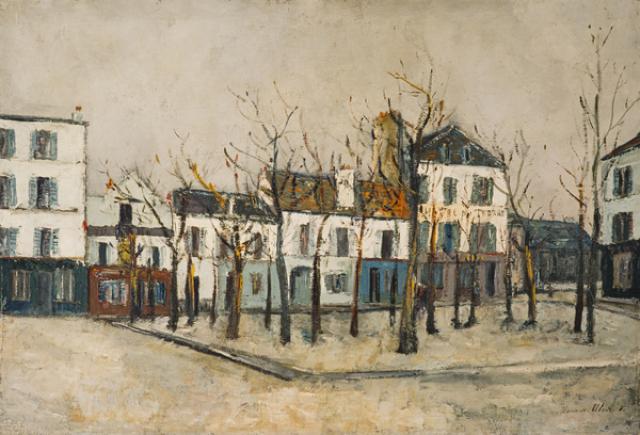
Not surprisingly perhaps, it seems that to some degree, the art of the deserted street is a kind of outsider art; Maurice Utrillo was an alcoholic with mental health issues, and although literally based at the centre of the Parisian art scene in Montmartre – because he was born there to an artist mother – he was nevertheless a marginal figure, and his paintings of his home town are heavy with melancholy and isolation.
Similarly, although far less gloomy, the Montmartre paintings of Maria Slavona, a foreigner – a German Impressionist painter living in Paris, are depictions of an urban landscape that, while not hostile, is enclosed and other and (to me) brings to mind the closing lines of Philip Larkin’s Here: “Facing the sun, untalkative, out of reach.” Whether that mood is inherent in the paintings, or only in the mind of the person looking at them, is not something I can answer.
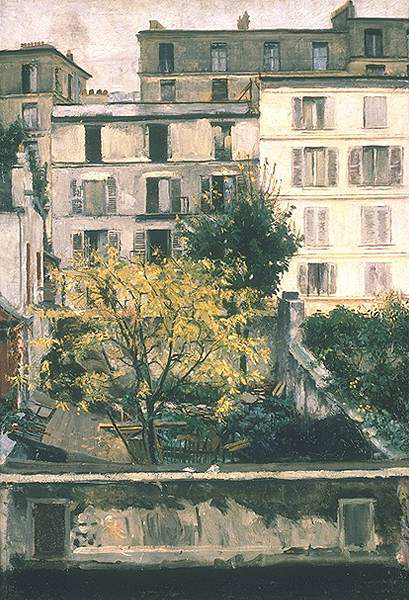
The German artists of a later generation found a similar sense of alienation at home. The neue sachlichkeit (‘new objectivity’) movement of the Weimar Republic may have been a rejection of the extremes of Expressionism and romanticism, but in its embracing of modernity it was a specifically urban movement too. The teeming street scenes of George Grosz and Otto Dix reflected the often-chaotic street life of Germany’s big cities in the social and economic upheaval following that followed World War One, much as Alfred Döblin’s Berlin Alexanderplatz (1929) was to do in literature, but there were other views of the city too. It was an era of political unrest, but if one thing united the political left and right it was the understanding that they were living in an essentially transitional period; that change would, and must come.
Hans Grundig was the epitome of the kind of artist hated by the Nazi party; politically a communist, he used his art to oppose the creeping rise of fascism but also to capture working class life in the city (in his case Dresden). But in Thunderstorm (Cold Night), 1928, it is the environment itself that condemns the society of the declining republic: the streets are empty and ghostly pale and the buildings, run down and near-derelict, offer little shelter and no comfort. The people whose fate looked uncertain, are nowhere to be seen, but meanwhile, a storm approached.
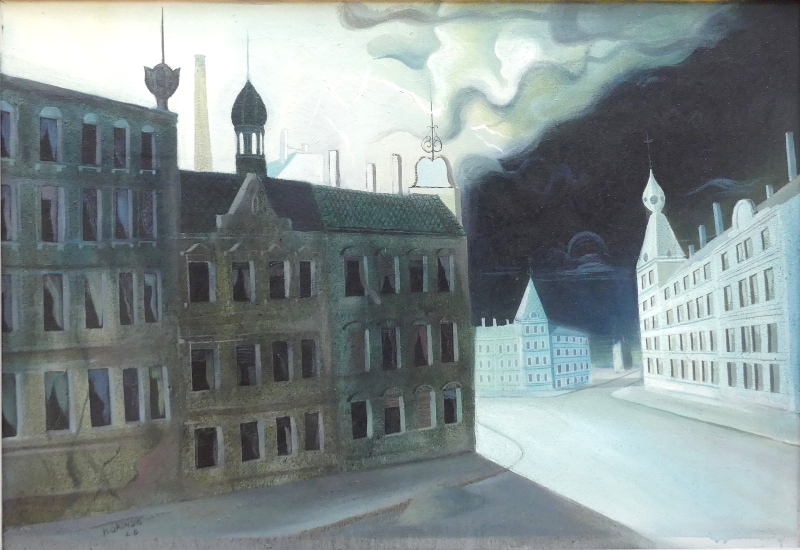
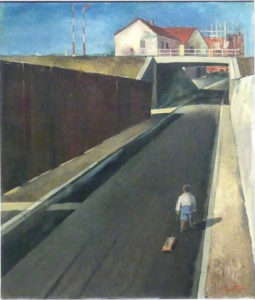
Carl Theodor Protzen was, by contrast, an establishment figure; a member of the Association of Fine Artists and the German Society for Christian Art, he was to become a pillar of the Nazi art community. Urban landscapes were his speciality and his depictions of Nazi building projects were to make his name, but just prior to the NSDAP’s rise to power in 1933, he was painting pictures like Lonely Street (1932) that show those same urban landscapes, but without the excitement of progress. Less bleak and doom-laden than Grundig’s city, this is nevertheless an environment which does not embrace or protect humankind; the title reflects the child’s exclusion from the harshly geometric scene in which he finds himself and, although there is no sense of exaggeration, the perspective, as in surrealism, pushes the end of the road ever further into the distance.
This perspective is seen too, in Volker Böhringer’s the Road to Waiblingen, painted in the year that the Nazis came to power. Böhringer, an anti-fascist painter, was later to become a surrealist, and the ominous (blood-stained?) road, stormy clouds and sinister trees suggest that this is (with apologies to Waiblingen) not a road that he saw leading anywhere very pleasant.
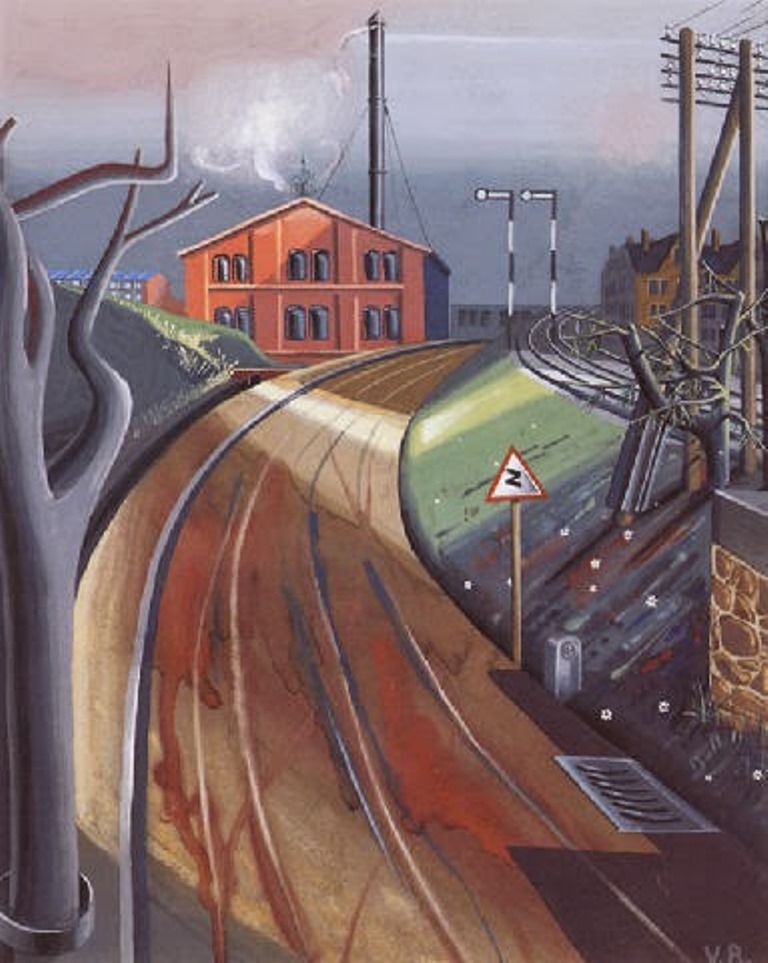
Ever since I was a child, I’ve always loved to visualise (usually at night) a real place, say a nearby hilltop or field, as it is at that moment, with nobody except animals and birds there to see or experience it. It’s a strange kind of excitement that depends on not being able to experience the thing you’re excited about. Psychology probably has a term for it, but at a time when people have never been more inescapable (not that one necessarily wants to escape them) there is something appealing about the complex landscapes we have created for our needs, but without the most complex element of all – ourselves – in them.
Whether we enjoy the empty streets or not (and hopefully we don’t have to get too used to them), we should probably take the time to have a good look at what is all around us; it’s a rare chance to see our world without us getting in the way.
